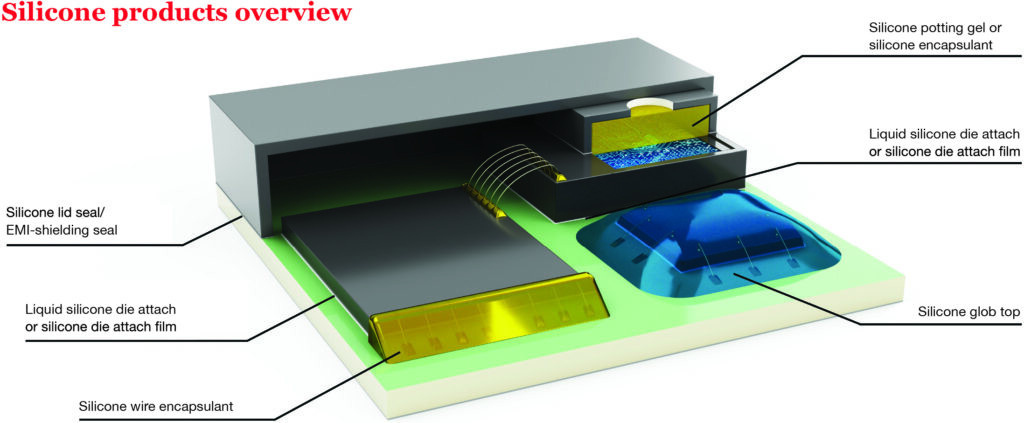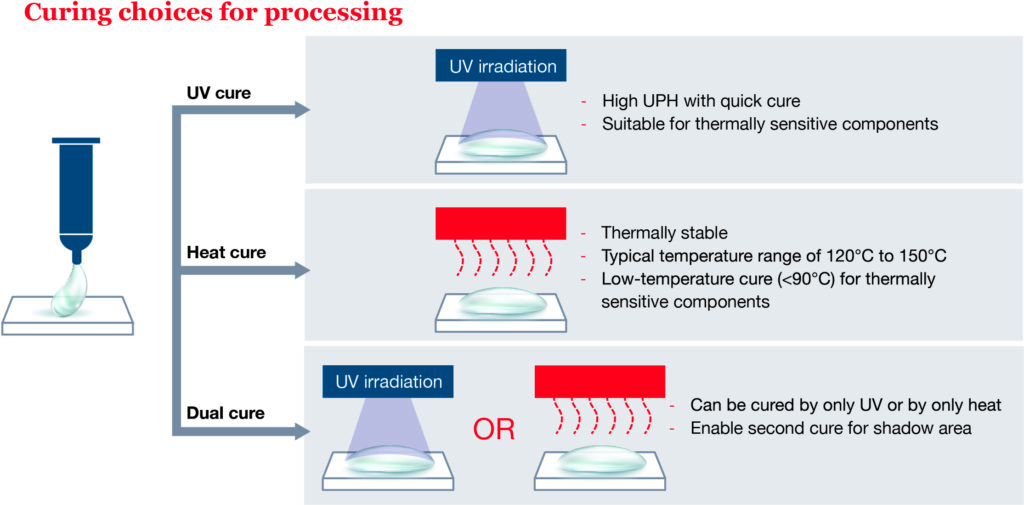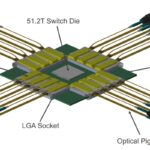by Jayden Cho, Manabu Sutoh, and Roderick Chen, Dow
The market for microelectromechanical system (MEMS) devices is growing, especially in the automotive industry. However, designers of these devices face engineering, manufacturing, and application challenges. For example, traditional organic adhesives may not be able to withstand the higher temperatures associated with today’s electronics, especially in 5G communications. On the other hand, silicones can resist these higher temperatures while imparting other valuable properties and supporting automated production for improved efficiency.
Compared to organic materials that can be used with MEMS devices, silicones also provide key advantages, such as:
- Greater temperature stability
- Better stress relaxation or coupling
- Broader and more durable adhesion
- Reduced risk of ionic contamination
- Fewer moisture problems during curing
- Fewer by-products and less shrinking
Today, many different silicone products are used in MEMS devices where a microelectromechanical sensor or actuator is packaged together with an integrated circuit (IC). These products include silicone adhesives, coatings, and encapsulants that provide bonding, environmental sealing, and thermal management.

MEMS designers need materials with stable electrical and mechanical properties over a wide range of temperatures to promote reliability. They also want reliable performance at high temperatures, both during assembly and end-use. Silicones combine temperature stability with high-temperature resistance up to 275° C. In addition, their lower modulus of elasticity across a wide range of temperature means that silicones can resist permanent deformation caused by stress. There are many causes of mechanical stress, but temperature-induced expansion and contraction are of special concern for microelectronics.
Different MEMS materials have different coefficients of thermal expansion (CTE), a material property that indicates the extent to which a material expands upon heating and contracts with cooling. Because MEMS devices use different materials, silicones help to absorb the stresses caused by differences, or mismatches, in thermal expansion. Whereas silicones are stress-relieving, organic materials such as epoxies have a high degree of stiffness because of their higher modulus of elasticity. This rigidity can cause epoxies to crack rather than quickly deform and return to their original dimensions when heat is removed.
Importantly, silicones provide broad and durable adhesion at both high and low temperatures. For example, MEMS devices subjected to reflow temperatures need adhesives that can withstand 250°C heat. Radio frequency (RF) MEMS, or RF-MEMS, devices in aircraft condition monitoring and distributed satellite communications need adhesives that can withstand low temperatures during use and high temperatures during device packaging.
With RF-MEMS switches, temperature stability is critical because large power signals can cause thermal deformation. For MEMS devices integrated into optical sensors, silicones combine temperature stability with outstanding optical properties such as clarity and resistance to yellowing. By contrast, organic materials such as urethanes and acrylates may yellow with exposure to ultraviolet (UV) light or fail during UV testing.
Microelectromechanical system designers also need materials that can adhere to various substrates and interconnects. Advanced silicone adhesives can bond to glass, metal, ceramics, and filled and unfilled plastics. They are also used to bond dissimilar materials, such as metal, to plastic. Silicone adhesives come in specialized formulations such as products with high thermal conductivity for heat dissipation and optical clarity for light transfer. In addition, there are advanced silicone adhesives that provide shielding against electromagnetic interference (EMI), a growing challenge in densely packaged electronics.
During microelectronic processing, ionic contamination in MEMS devices can lead to electrical defects, performance degradation, substrate leakage, resistivity variation, and dielectric charging. Although various cleaning methods can be used, wafer impurities and process particulates are some of the main reasons for MEMS device failure. Therefore, it is important to use only ultra-clean, high-purity adhesives, encapsulants, and coatings. Silicones have low levels of ionic impurities, which reduces the risk of ionic contamination for lower scrap rates and greater reliability. They also produce minimal by-products that can cause non-ionic contamination.
Additional advantages of using silicones for MEMS include fewer moisture problems during curing and less shrinking. At reflow temperatures, excessive moisture can interfere with curing. Problems include adhesives that won’t stick and surface mounted components that detach. Because they absorb low levels of moisture, silicone adhesives reduce these risks. Their minimal shrinkage provides greater dimensional stability, even under low- and high-temperature conditions. With accelerated heat curing, silicones can promote higher production throughputs and help to increase energy efficiency.

Silicones for MEMS sensors and actuators are supplied as different products, including:
- Liquid die-attach adhesives
- Cured die-attach film
- Encapsulants
- Wire and die coatings
- Optical materials
Because these silicone products have well-balanced properties, they can help MEMS designers meet a range of challenges. Advanced silicones also support the use of automated or semi-automated production equipment, such as needle dispensers or jet dispensers, for liquid die-attach adhesives and encapsulants. Automated dispensing is also used with encapsulation for environmental protection. Support for automation is important since MEMS devices are typically manufactured in large batches to achieve economies of scale. With automotive and 5G applications, the required volumes may be especially high.
As the sales of new cars increase and 5G networks become more widespread, advanced silicone materials will continue to enable today’s MEMS technologies and tomorrow’s innovations. By choosing a silicone supplier with the right combination of technical experience and demonstrated expertise, MEMS designers can find the right solutions to difficult but not insurmountable engineering, manufacturing and application challenges.
About the Authors
Jayden Cho is Global Segment Leader at Dow, Korea. Cho’s career spans 17 years in silicones for electronics, acrylic industrial tapes (PSAs) for electronics and silicones for the building industry. He holds a bachelor’s degree in Polymer Science Engineering from Dankook U., Korea. Email kcho2@dow.com
Manabu Sutoh is a Research Scientist at Dow, Japan and serves as a research scientist for electronics, displays, and microelectronics. He has been with Dow for 31 years serving various industries such as industrial, automotive, photovoltaic, and electronics to develop customized curable silicone products. He holds a Bachelor’s degree in Industrial Chemistry from NIHON U., Japan.


Leave a Reply